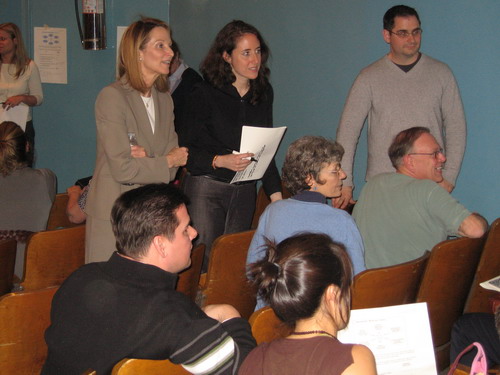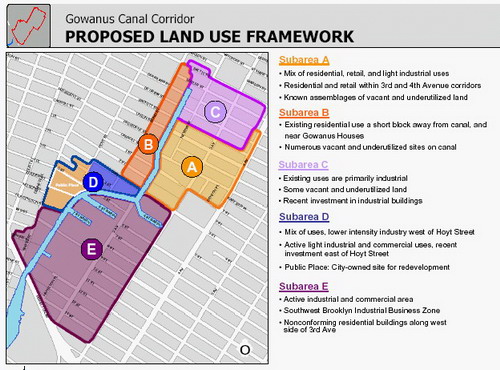Burden Calls Gowanus "Great, Unique" Opportunity at Polite Rezoning Meeting

Anyone expecting fireworks at the Gowanus meeting last night held to lay the groundwork for an upcoming rezoning that will change the face of the neighborhood would have been disappointed. More than 200 people turned out for the session held at PS 32 on Hoyt Street held by the Land Use Committee of Community Board 6, but it was a polite affair. It was billed as an effort to solicit neighborhood input for the rezoning "framework" being developed by the City Planning Department. The neighborhood got the city's planning all-star team and a full court press to try to impress residents that Gowanus plan and rezoning would be developed with their input. Planning Commission Chair Amanda Burden attended as did Purnima Kapur, head of the Planning Department's Brooklyn Office.
Gowanus is "one of the great unique opportunities in the city, but one of the great challenges," Ms. Burden said. "The Gowanus Canal is like no other place in the city."
An earlier meeting was held on January 25 to present an analysis of neighborhood land use that might serve as the basis for breaking the neighborhood into different zones or areas. (See the map below. You can find documents from the first presentation on the "Gowanus Canal Corridor Framework" here.) Ms. Burden said the zoning effort is "a tremendous opportunity to open land at the edge of the canal to public access" and to deal with issues of the neighborhood's scale, creating affordable housing and achieving environmental improvements and cleanups. Large parts of the neighborhood are currently only zoned for manufacturing.
Project Manager Howard Slatkin made a long presentation laying out some of the general goals including public access to the canal, enhancing mixed use development, improving the environment, creating affordable housing and encouraging off-street parking. He said, for instance, that there is a "unique opportunity" to require waterfront access as part of the development process and said current waterfront zoning requirements that require walkways on the water up to 40-feet wide might be extended to Gowanus. Mr. Slatkin also show pictures of how canals are used in such cities as Amsterdam and Richmond, although his first slide, showing Venice, drew laughter. "It's a different example," he conceded, also citing examples in Hamburg and Providence as well as the Bronx River.
"Creating new waterfront open space can help create a revitalized canal," Mr. Slatkin said.
He also noted that the canal is in a valley between Carroll Gardens and Park Slope, which are both on hills and that the neighborhood sits within a 100-year flood zone, limiting the kind of underground development (for parking lots, for instance) that can be done. (100-year floods are likely to occur more than once every hundred years if storm intensity and frequency increases as predicted.)
Other general city goals include promoting affordable housing. One controversial option is the use of the heavily contaminated Public Place site for affordable housing. Another is the use of inclusionary zoning, which gives developers density bonuses of up to 33 percent for including affordable units either in a development or nearby.
The meeting broke up into nine discussion groups where resident talked about what they'd like to see come out of the zoning and planning process. In one group that we sat in on, residents discussed creating a continuous park-like esplanade along the canal. One proposed developing cafes and restaurants on the water. Another suggested a small museum dedicated to Gowanus' industrial past. Another wanted a facility for performance and concerts. One resident asked for more access to the water itself, but a city official said that boating might not be included in the early version of the plan because of pollution issues. Residents in the group we watched also said they wanted to make sure that environmental cleanups are monitored very closely and that new developments be required to include solutions so that they don't add to the current amount of sewerage and storm runoff that goes into the canal.
Another group we watched that was being run by Ms. Kapur of the Brooklyn planning office was focusing on ways to preserve industry in the neighborhood and balance it with new development and public access. One business owner said, "We need to be where we are."
When Ms. Burden, who was going from group to group, joined the discussion, Joe Ferrara of Ferrara Brothers Concrete, which occupies a prime lot on the canal that is being eyed for redevelopment as part of Public Place, took her aside. He noted that family bought the land in 1973 so that it could have access to barges and that volume is 245 percent higher this year than last. He listed all the major New York City projects for which Ferrara is supplying concrete, including the massive new water tunnel being built and WTC site redevelopment. "To throw us to the wolves is really not a good idea," he told Ms. Burden.
All of the discussions we saw were polite and thoughtful, although dozens of people left the meeting when it was clear they wouldn't be able to make public statements to the entire audience. Generally, residents seemed to want contextual zoning, a clean up of the canal and a way to handle competing uses such as manufacturing and public access to the canal.
Speaking toward the end of the meeting, City Council Member David Yassky cited the controversial Greenpoint-Williamsburg rezoning as "a good model to look to" for rezoning Gowanus. Mr. Yassky said he was not referring to the height of buildings allowed under the rezoning (up to 40 stories), but to a process that "accommodated all interests."
Michael Ingui, who is co-chair of the Gowanus Canal Community Development Corp., which produced a Gowanus Comprehensive Plan that was released late last year and has created the Gowanus Canal Conservancy to push for a cleanup, said the meeting "is a great start to the process" and that he was impressed at the range of community interests that had come and that were able to work together.
More meetings with City Planning will follow and there will be a long series of presentations and public hearings before any rezoning is approved. Stay tuned.


2 Comments:
very interesting. glad to read it. great coverage. nice work. confirming, as if confirmation were necessary, why i check gl FIRST.
the picture is set as private.
i'd like to see the larger version.
help!
Post a Comment
<< Home